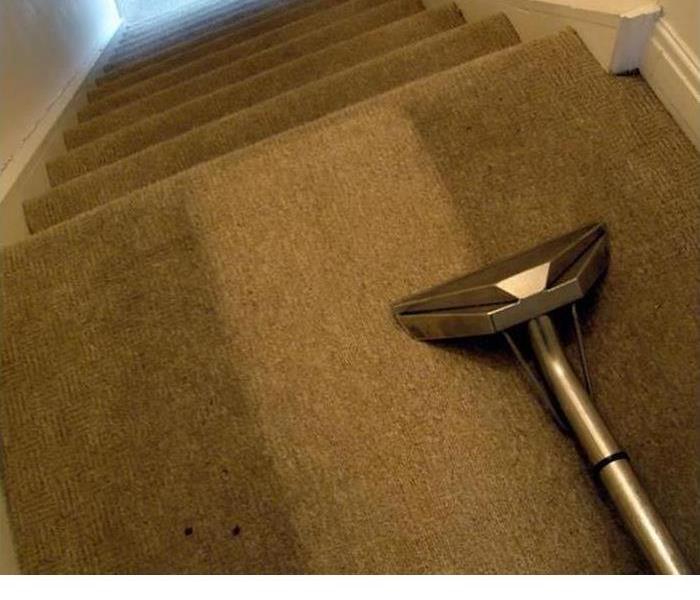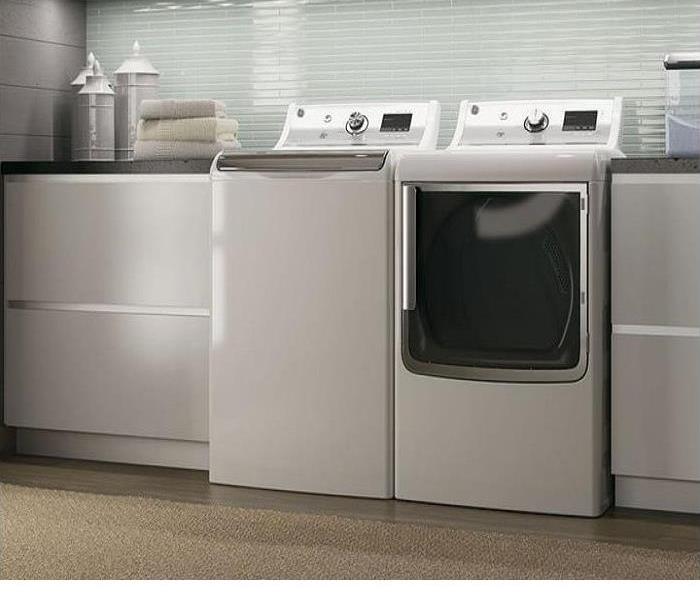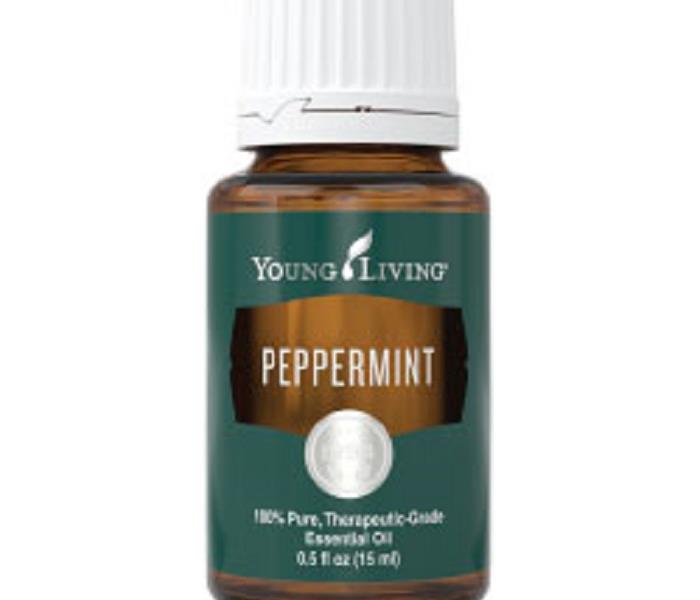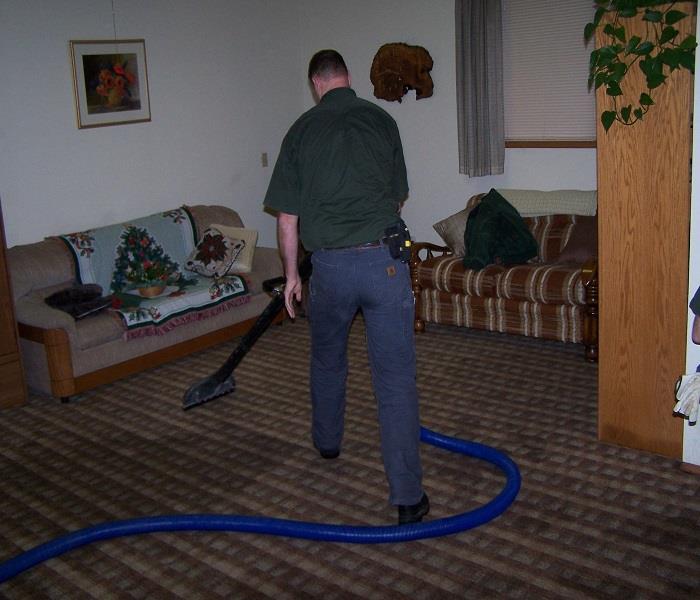How Often Should Carpets Be Cleaned?
4/17/2020 (Permalink)
 Have SERVPRO of Olympia clean your carpets.
Have SERVPRO of Olympia clean your carpets.
HOW FREQUENTLY DO YOU HAVE YOUR CARPETS CLEANED?
Call SERVPRO of Olympia to schedule your carpet cleaning today!
Have you ever wondered how often you should actually get your carpet cleaned?? According to IICRC, they recommend homeowners have their carpet cleaned 1-2 times a year!! Not only does clean carpet look good, it promotes indoor air quality, reduces health risks, and extends the life of the carpet.
Carpet cleanings should be maintained on a schedule, just like changing your furnace filters! If you have indoor pets, have large families, have someone that smokes inside your home, or just the sheer fact that you have had to stay home during the quarantined period increasing the frequency would be very beneficial for you!
We also offer a range of specialized cleaning methods:
Hot Water Extraction: A deeper cleaning method for all carpet types.
Deluxe Precondition and Rinse: Helps restore deeply soiled areas.
Call SERVPRO of Olympia today at (360)754-9689 to schedule your carpet cleaning!
Clean Your Washing Machine
6/13/2017 (Permalink)
 Clean Your Washer The Right Way
Clean Your Washer The Right Way
THE RIGHT (AND WRONG) WAY TO CLEAN YOUR WASHING MACHINEAs much as we hate doing laundry, most of us can’t imagine life without a washing machine. These trusty machines are there for us through minor stains and major ones — food spills, sweaty socks, and even the most disgusting stains we get on our clothes. But like everything else in our homes, even our washing machines get dirty. Really dirty.
Have you ever noticed that gunk that builds up around the washing machine door jam? What about the grains of dirt and sand that accumulate inside of the machine’s drum? Let’s not forget to mention the bacteria you can’t see with your naked eye, like mold and mildew. When you have dirt and grime inside of your washing machine, this can impact your machine’s performance, and the cleanliness of your clothes. It’s time you washed your washer.
To avoid damaging your washer or your clothing, you need to maintain and care for your machine properly — and that’s true whether it’s brand new and beautiful or the reliable one you’ve had for years. We’ve put together some tips on how to correctly clean your washing machine, as well as some washer-cleaning methods to avoid. Here are the right (and wrong) ways to clean your washing machine.
HOW TO CLEAN A TOP-LOAD WASHER
Step 1: Leave the door open after you remove your clothes, and allow your washer to dry out completely when you’re not using it. This helps prevent mold and mildew from growing in your washing machine.
Step 2: Use a damp cloth and a small amount of liquid detergent to wipe the inside of your machine.
Step 3: Wipe up any dirt, spills, and grime from your machine’s exterior and from the door jam with a damp cloth and mild soap.
Step 4: Change the fill hoses on your machine every five years, per the recommendation of GE. It’s a good idea to label your fill hoses, indicating the date you replaced them. Just label some masking tap with a Sharpie.
Tips: We asked GE for suggestions on how to clean top-load washing machines properly. The appliance company suggested we use Tide Washing Machine Cleaner once a month to clean and freshen the unit, and to refer to the washing machine’s owner’s manual for additional cleaning and maintenance instructions.
What not to do: It’s best to avoid using harsh cleaners, notably those that contain ammonia. You should also shy away from anything that’s too abrasive, like gritty cleaners or Brillo pads. Harsh cleaners can damage you machine.
HOW TO CLEAN A FRONT-LOAD/HE WASHER
Step 1: Leave the door ajar after you remove your clothes with a front-load washer as well, and allow it to dry out completely when you’re not using it. This helps prevent mold and mildew from growing.
Step 2: Clean the washer door by wiping it down with a damp cloth.
Step 3: Clean the door seal. Gently pull back the seal between the door opening and the drum, and check for foreign objects; remove any you find. After that, check for stains or dirt buildup. Clean dirt buildup using either washing machine cleaning wipes, Finally, allow the washer to air dry completely with the door open.
Step 4: Clean and sanitize your detergent tray. Take the tray apart (if applicable) and soak it in hot water and mild soap for about 20 minutes.
Step 5: Clean the inside of the washing machine. Most HE washers have either a “clean cycle” or a “clean with Affresh cycle.” To run a clean cycle, add ¼ cup of Benifect to the bleach dispenser and run an empty load.
Tips: It’s best to use HE detergent when you have an HE washer, and to avoid using too much detergent, as this can cause excess buildup. Lastly, use warm and hot water washes periodically (but not all of the time), as warmer water can help control soil and detergent buildup, per the recommendation of Maytag.
What not to do: Some HE washer owners run a clean cycle only, and neglect the other steps. You should try to clean your HE washing machine every 30 wash cycles, and follow all of the steps to make sure you are not allowing dirt and grime to accumulate in other parts of your machine.
HOW TO CLEAN A SELF CLEAN OR SMART WASHING MACHINE
Step 1: Clean the control panel with a damp cloth.
Step 2: Clean the mesh filter of the water hose once or twice a year. To do so, soak the filter in water until it is clean (make sure the threaded connector is also submerged). Then allow the filter to dry completely in a shaded area.
Step 3: Clean the dispensers. Rinse the inserts in warm water to remove traces of accumulated detergent and other laundry products. Then clean the recess with a toothbrush to remove residue.
Step 4: Clean the interior: You can wipe it with a damp cloth and a washer-safe cleaner. Also, run the self-clean cycle when the indicator light comes on. Self-clean helps get rid of mold that grows inside of your washing machine.
Notes: These instructions are for a Samsung top-load self-clean washing machine. Your machine may have different parts and cleaning instructions. It’s best to refer to your owner’s manual to obtain the specific cleaning instructions for your washing machine. If you misplaced your owner’s manual, you can likely locate it online by visiting the manufacturer’s website and searching for it using your model and serial number.
Tips: Clean the outside of stainless steel machines using stainless steel cleaner, vinegar, or Windex. When you clean stainless steel, it’s best to go with the grain. You can also use a little bit of rubbing alcohol to dissolve oily finger prints, per Better Homes and Gardens. Also, if you have a shiny metallic finish on your washer’s exterior door, you can clean that surface using a small amount of Cerama Bryte and a clean, damp, non-abrasive cloth, per the recommendation of Samsung.
What not to do: Do not use harsh or abrasive cleaners when cleaning the control panel, and avoid using bleach cleaners on stainless steel surfaces. Also, do not run self-clean cycles while you have laundry in your machine.
Essential Oils
6/11/2017 (Permalink)
 Get rid of those pests
Get rid of those pests
Ask Angie's List: Can you get rid of home pests with essential oils?BY PAUL POGUE, ANGIE'S LIST Angie's List Sometimes the most natural methods work best. You can get rid of mice using a reliable old snap-trap, and nothing takes out spiders like a rolled-up newspaper. But if you want to get rid of spiders and mice with minimal force, essential oils may be the solution for you.
Peppermint oil pest control is an effective means of repelling spiders and mice. Spiders smell through their legs, and so they're very sensitive to oils on the surface. Mice rely on their sense of smell, so they tend to be turned away from distinct essential oil odors. Mice tend to follow pheromone trails left by other mice, and peppermint oil confuses those senses.
As a bonus, essential oils are environmentally friendly and safe for your family and pets compared to toxic chemicals.
HOW TO PREPARE ESSENTIAL OILS FOR PEST CONTROL
You have three options for setting up essential oils to repel mice and spiders: sprinkling it directly, spraying it or soaking cotton balls.
If you know where pests are coming in, or have a suspicion – such as crevices, cracks, windows, and other hiding places – you can apply a line of undiluted oil across that entrance point. You can also create a diluted mix of water and a small amount of peppermint oil and spray it across a wider area. This is particularly useful if you're not sure where they're getting in and want to cover an entire corner or window.
You can also soak cotton balls in undiluted oil and place them near the entrances you want to block.
PEPPERMINT OIL: SPIDERS
Peppermint is the most effective oil to repel spiders. Besides peppermint and spearmint, essential oils for spiders include citrus elements like orange, lemon and lime. Citronella, cedar wood, tea tree oil and lavender can also be effective.
However, consider whether you want to get rid of spiders at all. You obviously want venomous spiders to be far away, but in many cases, especially if they're outside windows or doors, spiders are effective pest control all their own! There is no better natural insect exterminator than the spider, and no more potent bug repellent than a spider's web.
PEPPERMINT OIL: MICE
As with spiders, peppermint oil is an effective deterrent, but you need to keep several drawbacks in mind. Essential oil is not a long-lasting product; it will need to be replaced every few days. And especially in the case of mice, you want to check those peppermint-soaked cotton balls every so often. Once the odor fades away, that cotton will make attractive nesting material for the mice.
You want to make sure you place the essential oils right where mice are entering, rather than where they're already getting in.
Generally, you want to combine peppermint oil pest control with other measures. For mice, plugging up holes with steel wool tends to keep them out, since they have a hard time chewing through it.
Peppermint oil pest control may seem like a low-impact and simple approach, but it can be very effective. If you place the oils correctly, they should act as a virtual force field, telling pests in no uncertain terms to go the other way.
Paul Pogue is a reporter for Angie's List, a trusted provider of local consumer reviews and an online marketplace of services from top-rated providers. Visit AngiesList.com.
Carpet Cleaning At Its Best
7/14/2016 (Permalink)
 Truck Mounted Steam/Extraction Method
Truck Mounted Steam/Extraction Method
The SERVPRO carpet and upholstery cleaning service will not only get out the dirt you see, but will also remove the unwanted dust you don’t. A professionally cleaned carpet and furniture may make all the difference in brightening up a room and freshening up your home.
Carpet cleaning, for appearance, and the removal of stains, dirt, and allergens is done through several methods. Clean carpets are recognized by manufacturers as being more visually pleasing, potentially longer-lasting, and probably healthier than poorly maintained carpets.Although there is an actual steam cleaning industrial process, in the context of carpet cleaning, "steam cleaning" is, in fact, hot water extraction cleaning. The hot water extraction cleaning method uses equipment that sprays heated water, sometimes with added cleaning agents, on the carpet. Simultaneously, the water is vacuumed up, along with any dislodged and dissolved dirt. Many carpet manufacturers recommend professional hot water extraction as the most effective carpet cleaning method. SERVPRO of Olympia offers this method along with methods for those who are chemical sensitive. CALL TODAY for SERVPRO of Olympia to give you a FREE ESTIMATE. (360)754-9689



 24/7 Emergency Service
24/7 Emergency Service


